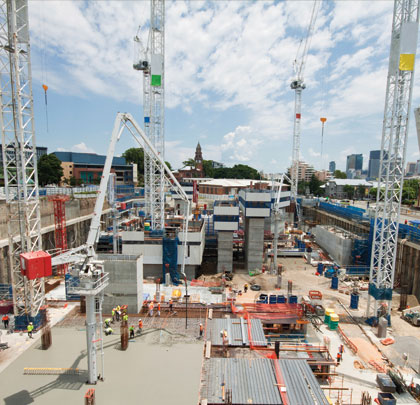Shims are used by the hundreds on the jobsite. They serve as temporary alignment aids to hold objects in place until they can be attached or as a permanent solution for maintaining spacing within joints. Because of their small size and modest role, shims are often overlooked by designers and specifiers. However, a shim that becomes a permanent part of construction, as is common with glazing or other panelized systems, needs to offer performance equal to its surrounding materials in order to avoid becoming the system’s weak point. Even temporary shims need to meet basic requirements for size, strength, and ease of use—and they can speed up installation if they are available in standardized units. For these reasons, purpose-made structural plastic shims are making a place for themselves in highly detailed structural systems and/or where fast paced construction is desired.
THE ADVANTAGES OF PLASTIC
Structural plastic shims represent an improvement over traditional wood and metal shims because, unlike wood, they are resistant to crushing and rot. They are more economical than steel and will not rust. They require little to no shaping, as they are available in various widths and in shapes that are easily cut to size. Many suppliers offer shims in 152- and 203-mm (6- and 8-inch) wedges that are notched to be snapped at convenient lengths and depths. Structural plastic shims have consistent thicknesses, and are often color-coded, which simplifies installation and inspection in the field. The shims are also stackable. Some products can fit virtually any size joint just by combining standard sizes. Plastic shims can be banded together, or, in some cases, heat-welded at the edges. All of these advantages add up to a significant savings in labor time.
SELECTION CRITERIA
Flat block shims can be used in simple conditions where spaces will later be filled with grout or sealant. U-shapes fit around bolts and can be useful for many systems of construction, including precast concrete cladding and curtain wall systems, where they usually form permanent spacers.
Shims come in a range of compressive strengths and care should be taken to select a shim that can withstand the expected compression load that it will carry. During construction, before final fastening is complete, shims must support large loads over their small footprints, so including a safety factor is a good idea. During the installation of glazing systems, it is also necessary to have a shim that is impact resistant (i.e., it can withstand a sudden force, usually over a small area, without breaking or crushing). When an extremely high degree of impact resistance is required, high-impact polystyrene shims may be required.
Because they have a lower thermal conductance than aluminum or steel, plastic shims can act as a thermal break between conductive materials. For example, they can help reduce thermal transfer from cladding materials, such as precast concrete into structural elements. Structural plastic shims, if they are specially ordered, can meet the fire safety testing and performance standards of UL94V-0.
Inert plastics, particularly polypropylene and polystyrene, are chemically compatible (non-reactive) with most building materials. They do not transfer color or oils, produce stains, or corrode the item being shimmed. Many common building materials need to be separated from one another due to their reactivity; for example, aluminum must be separated from concrete and from steel.
SPECIFICATION OF SHIMS
Depending on how a project is specified and delivered, the design professional may legitimately leave most aspects of shim selection to the contractor’s suppliers and installers. If a system’s overall performance is adequately specified, and if the contractor’s responsibility for that performance is clear, the shim’s contribution to system performance is also the contractor’s responsibility.
In engineered systems where the design team is tightly controlling other materials within the building system, they should also specify shims. For example, when a fragile stone is chosen for wall cladding, designers need to carefully detail the support system for that stone, including the shims. In any situation where shims are being relied upon to provide functionality, such as fire resistance or the reduction of thermal transfer, designers must specify the shim.
Shims are considered accessories and may be specified with other parts of the building system in which they are used. A specifier is not likely to require a specific shape or size of shim, but types or material properties may be specified. For example, in applications where load-bearing is important, solid shims may be specified. Compatibility, resilience and fire resistance are other material properties that may be specified. Execution requirements for shims should be results-oriented. For example, specs may state, “Shims shall not remain permanently exposed to view, sun, or weather,” or “Do not shim cladding more than ½ inch thick without written acceptance by engineer.”
CONCLUSION
From simple, temporary applications to structural roles within specialty cladding systems, shims can be selected in such a way as to speed installation and enhance building performance. Their available features give the project team consistent results in an array of circumstances. Therefore, even small building components like shims can play an important part in a project’s success and in its bottom line. ■
About The Author:
Simon Braune, vice president, is the third generation of the Braune family to work at Grove Products, Inc., the leading producer of plastic structural shims. For more information, visit www.groveproductsinc.com.
_________________________________________________________________________
Modern Contractor Solutions, December 2013
Did you enjoy this article?
Subscribe to the FREE Digital Edition of Modern Contractor Solutions magazine.

Small But Mighty


